Introduction
Bell pepper (Capsicum annuum L.) is a source of vitamins A, C, E, B1, potassium (K), phosphorus (P), calcium (Ca), polyphenols, carotenoids, sugar and with high antioxidant content such as capsaicin and capsanthin (Aminifard, Aroiee, Ameri, & Fatemi, 2012). In Colombia, in 2014, the national area harvested for consumption was 2378 hectares of which 320 were established in Antioquia, and about 99%, under open field conditions (Agronet, 2017).
Villa, Ulery, Catalán & Remmenga (2003), found differences between the yields and treatments in "Sandia" hybrid which was grown under greenhouse conditions in two growing seasons (31 and 35°C ), with different N doses and in a soil with several salinity levels. Nevertheless; yields increased as well as N levels in lower temperature, while up to 35°C, yields decreased and soil salinity increased.
In addition, Aminifard et al. (2012), looking for best plant density and the appropriate nitrogen level for bell pepper, realized that the highest plant heights, leaf chlorophyll levels and yields are reached using 50 kg.ha-1 of N in the open field condition. It is important to highlight that there were not any significant statistical differences with doses of 100 and 150 kg.ha-1 of N. Respectively, doses above 50 kg.ha-1 decreased yields possibly due to toxicity in the plant.
Alternatively, Albuquerque, Silva, Bezerra, Souza & Santos (2012), evaluating the Maximo's F1 hybrid in open field condition under five (5) irrigation levels and two (2) doses of K2O, found that the best combination was 80 kg.ha-1 with an irrigation level close to 100% of crop evapotranspiration, obtaining an adequate macronutrient levels and avoiding deficiencies while reducing nutrients loss to the minimum due to excessive water and fertilizer applications.
This research is about the nutritional requirements of bell pepper under two development conditions. Given that this crop diversity responses to different factors that intervene in its production, its nutritional unbalance caused by fertilization practices with no chemical analysis of soil, and the lack of research for supporting applied doses, this study aimed to orient growers and to contribute to the crop integrated management.
Material and methods
At the research center (R.C.) La Selva of CORPOICA, located in LLanogrande township of Rionegro, Antioquia - Colombia at a latitude of 06° 08' 06'' N and a length of 75° 25' 03'' W with an altitude of 2120 m. a. s. l., and annual averages of 17° C, rainfall 1917 mm, relative humidity 78%, solar brightness 1726 hours per year, and an evapotranspiration 1202 mm. Located in the ecological living area of Low Humid Montano Forest (bh-MB). A study was carried out with four (4) fertilization recommendations in two (2) environments for bell pepper cv. Nathalie crop during the second half of 2014, in a soil cartographic unit of Rionegro Association with Typic Fulvudands taxonomy (García, 2007).
Based on the soil chemical analysis, bell pepper crop requirements and fertilizer efficiency, a balance was carried out for a yield of 60 t.ha-1 of fruit. Magnesium, potassium and manganese content were low in protected condition, while Manganese and Sulfur content were low in Open field condition. No lime or organic matter (O.M.) were applied because the pH was slightly acidic, with no aluminum content present that could limit the development of the roots; likewise, O.M. was high (Table 1). The nutritional balance did not show a fertilization need. The furrows and streets were covered with the "Agromulch" padded plastic and residues from weeding - previous crops for weed control and soil moisture conservation.
Table 1 Chemical analysis results of the soil where the study was established. Rionegro (Antioquia), 2014-B
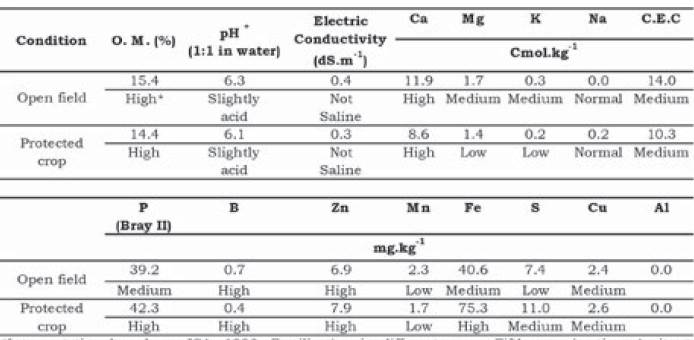
*Interpretation based on: ICA, 1992 , Fertilization in different crops. Fifth aproximation. Assitant manual N°25.
* pH interpretation was carried out with potentiometer, electric conductivity with conductivimeter (soil:water: 1:2.5), O.M. with the proposed methodology by Walkey & Black, P by Bray II method, S and B with calcium phosphate monobasic, Al with KCL, Ca, Mg, K and Na with ammonium acetate 1N pH 7.0; Fe, Mn, Zn, and Cu with modified Olsen.
Four (4) fertilization formulations were established using the requirements reported by Casilimas, Monsalve, Bojacá, Gil, Villagrán, Arias & Fuentes (2012); ICA(1992), adding one treatment below that reference without reaching zero and one above (Table 2). These treatments were established in experimental units of 17.6 m2, with 0.8 m among furrows and 0.4 m among plants. Also, they were set up, in a split-plot design where the main plot was the condition under which the crop was developed ("Open" and "Protected" field under plastic cover) and the subplots of the four (4) treatments were distributed in complete random blocks design with three (3) replicates.
Table 2 Fertilization levels applied to the bell pepper cv. Nathalie crop under Open and Protected Field conditions. Rionegro (Antioquia) 2014B.
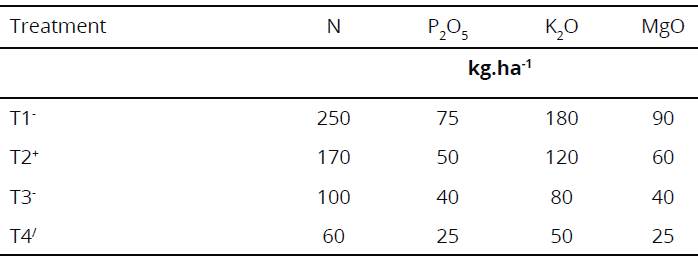
Source: +Casilimas et al. (2012).
Tight or interpolated: ICA (1992).
Bell pepper seed was planted in trays of 23 alveoli, with a substrate composed of soil, peat and sand in a ratio of 3: 1: 1. Subsequently, transplantation was performed at 49 days after sowing (d.a.s.).
The fertilization was carried out in four applications, in strips at a depth of 10 cm, covering the products with soil to avoid its loss by evaporation and surface runoff. Hence, applications were as follows: the first, at the moment of transplantation with all phosphorus, magnesium, 30% of potassium and minor elements; the second, at 30 days after transplantation (d.a.t.): 30% of potassium, minor elements and 50% of nitrogen. The third application, at 60 d.a.t.: 20% of potassium, minor elements and 25% of nitrogen; and finally, a fourth application: at 90 d.a.t.: 20% of potassium, minor elements and 25% of remaining nitrogen.
The pests and diseases incidence was weekly evaluated for their management. The severity of the most limiting (thrips, microlepidoptera and powdery mildew), was measured by randomly monitoring three plants per plot. Black cutworm (Agrotis sp.), was controlled with bait based on wheat bran, molasses and Chlorpyrifos, in a proportion of 2 kg: 1 L: 5 cc, respectively. The incidence of aphids, whitefly (Trialeurodes sp.) and Copitarsia sp., was low (4, 1 and 2%, respectively). A preventive pest management was established with a rotation of biological products such as: Lecanicillium lecanii, Beauveria bassiana, Bacilus thuringiensis and agricultural oil.
In this sense, the disease with the highest incidence (70%) was the powdery mildew (Oidiopsis sp.), between weeks 10 and 11, the highest degree of severity (between 2.8 and 2.9) in the first third of the plant, was recorded. At this point, when the severity was higher than grade two (2) in the same stage of the plant, the control included integrated management techniques such as cultural control (pruning of affected leaves), and rotation of biological products (pentahydrate copper sulphate, polysulfide calcium, inter alia).
Therefore, the maximum temperature under protected conditions exceeded, in the months of October 2014 and March 2015, up to 12 °C the ones registered in the open field condition. On average, a difference of 8.7 °C was observed among two conditions (30.8 and 23.2 °C Protected and Open Field, respectively). Minimum temperatures showed no significant differences. The intensity of solar brightness showed a decrease at the beginning of the flowering stage, between the months of October - November 2014 and at the end of the vegetative cycle, which are crop periods that coincided with the rainy seasons. The indoor environment was drier, reaching differences of up to 5% in October - November 2014 and March 2015 (Figure 1).
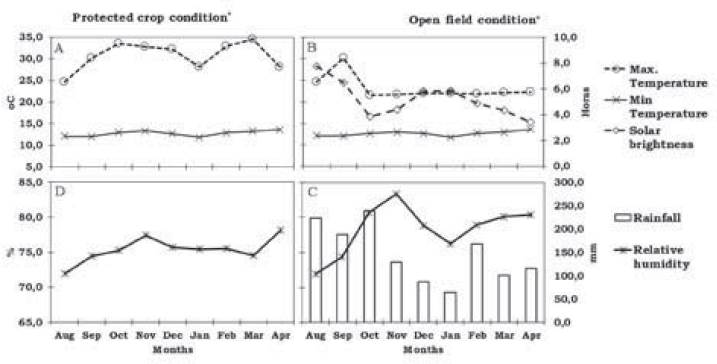
Source:For + openfieldcondition:IDEAM,2016. Weatherstation José María Córdoba airport, Rionegro (Antioquia). For* protected crop condition: records with USB / Data logger hermohigrometer, model CM-DT171.”
Figure 1 Temperature (°C), relative humidity (%) and rainfall (mm) from August 2014 - April 2015. Rionegro, Antioquia.
A Degree Day Utility version 2.3 (University of California, 1994) software was used to estimate degree-day accumulations (d.d.) or thermal time used in agriculture to quantify and predict phenological events because they are more accurate than the use of chronological time or seasons of the year. To determine the amount of temperature available for the development of an organism in any location, the double-sine with a vertical cutoff method was used. According to Roltsch, Zalom, Strawn, Strand & Pitcairn (1999), this is the most accurate method of calculating degree-days, and it is assumed that the development of any "ectotherm" is stopped or there is no accumulation of thermal time when the air temperature is below or above the minimum or maximum threshold defined for the species. In the present study, the maximum temperature threshold of 35 °C and minimum of 18 °C were taken, where the assimilation rates of bell pepper crop were not affected according to the report by Aloni, Pashkar & Karni (1991).
The d.d. during the crop vegetative period, showed under protected condition, in flowering stage and in the 50% of the initial flowering, that it exceeded in 137 (53%) and 239 (64%) d.d. respectively to those registered in the open field condition (Figure 2). The data presented a normal distribution (Kolmogorov-Smirnov p>0.05) and significant statistical differences among two groups, according to t-student and non-parametric Mann-Whitney tests (p<0.05).
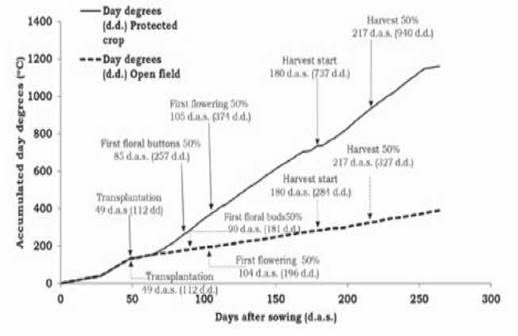
Figure 2 Degree-day accumulations (d.d.) or obtained thermal time under two development conditions of bell pepper cv. Nathalie Rionegro (Antioquia) 2014-B.
Another procedure made during the study was drip irrigation which was applied with an efficiency of 90%, with integrated droppers every 20 cm and an average unit flow of1.2 L.h-1. Taking into account that, under protected conditions, no rainfall inputs are received and all irrigation levels were applied.
In addition, the stem diameter was measured at two (2) centimeters of the base and the height of the plant in four (4) moments (14, 16, 18 and 20 Weeks After Seeding -w.a.s.-), and their Relative Growth Rates were determined (RGR: RGR-height and RGR-diameter), with the modified formula proposed by Hastwell & Facelli (2003). Finally, the performance components were evaluated, classifying the fruit by categories as follows: Extra, First (I) and Second (II), accordingly to crop requirements for bell pepper of the United Nations (UNECE Standard FFV-28, 2009).
Therefore, data were processed in the SAS 9.3 software, applying tests such as analysis of variance (ANOVA) of replicated measurements, with an adjustment of the covariance structure using mixed models. This was followed by an evaluation of the methods of symmetrical composite structure, unstructured modeling and autoregressive structure of first order. Furthermore, normality (Shapiro-Wilk and Kolmogorov-Smirnov), homogeneity of variances (Levene) and Mauchly's sphericity, with a = 0.05, were determined. A multiple comparison of means was performed with the Tukey and Least Squares tests. The assumptions of the models were verified by examining residues.
Results
Accordingly to ANOVA, the effect of treatments and their time interaction of the plant height, stem diameter, RGR-Height and RGR-Diameter variables, were not significant (p>0.05), indica ting that the differences between the treatments, over time, were maintained. Differential nutrient inputs were not reflected in an increase or de crease in the values of these variables, compared at a given time (Figure 3 and 4). The effect of the conditions (Open and Protected) under which the crop was developed, the times of the evaluations and the interaction time by condition, presented significant statistical differences for these varia bles (p<0.05).
Under the Protected crop condition, plant height and RGR-Height presented the highest values over time, with significant statistical differences (p<0.05), exceeding on average 24 cm and 19 mm per week, respectively comparing to those developed in the Open field condition. The stem diameter and their RGR, on the other hand, were larger in the Open field condition, exceeding on average 7% and 34%, respectively the Protected crop condition, presenting a difference in stem diameter of 17% at the end of the vegetative cycle (Figures 3 and 4).
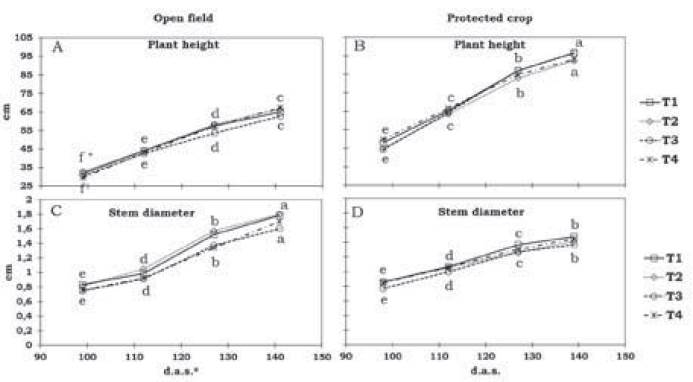
*d.a.s.: days after sowing. *Means with same letter in the same variable and among conditions, no differ significantly among them (test of means with mínimum squares or t-Test p>0.05)
Figure 3 Height plant -cm- (A and B) and stem diameter to 2 cm from soil -cm-(C and D), evaluated under two growth conditions: Open field and Protected under plastic cover. Rionegro - Antioquia, 2014B.
The effect of two crop conditions on total fruit yield, showed significant statistical differences (p<0.05), being 52% higher than those produced under Open field condition. The number of extra, first and second fruit variables was higher in 28, 31 and 30%, respectively (Figure 5). The effect of fertilization treatments on yield and number of fruit per plant, did not present significant statistical differences (p>0.05. Figure 6).
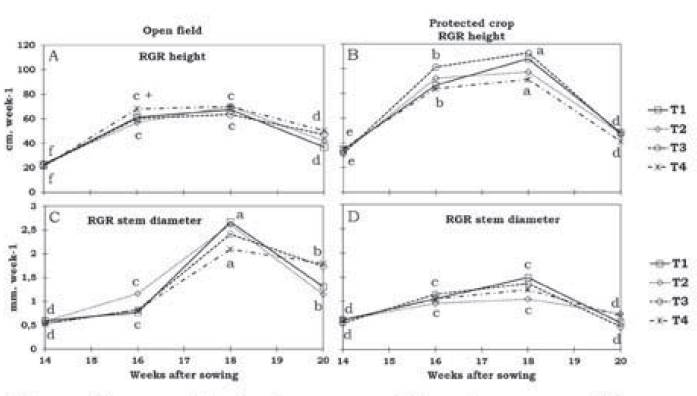
*Means with same letter in the same variable and among conditions, no differ significantly among them (test of means with mínimum squares or t-Test p>0.05)
Figure 4 Relative Growth Rate (RGR) based on plant height - cm per week - (A and B) and stem diameter measured from 2cm of the plant base - mm per week - (C and D), evaluated under two growth conditions: Open field and Protected crop under plastic cover. La Selva, Rionegro (Antioquia), 2014B.
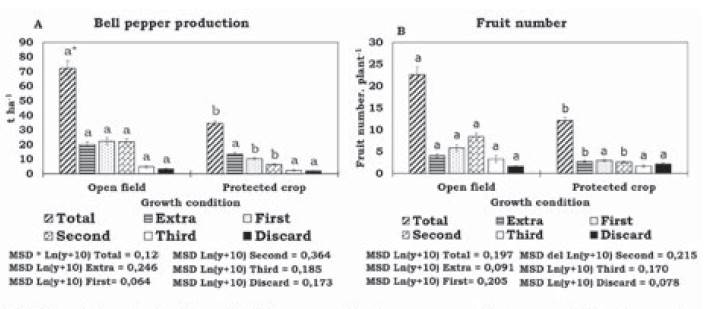
*MSD: minimal significant difference, *Series mean with same letter in each variable, are not statitically different (Tukey, p>0.05) Error bars correspond to the average standard error (SE), n=12
Figure 5 Bell pepper yield -t.ha-1-(A) and number of fruit per plant(B), under Open field and Protected crop conditions. La Selva, Rionegro (Antioquia), 2014B.
The interaction treatment per condition, for yield and fruit total number, was not significant (p>0.05), indicating that a similar treatment behavior was maintained in the two evaluated conditions. T4 of 60, 25, 50 and 25 kg.ha-1 of N, P2O5, K2O and MgO respectively, yields and fruit number (52 t.ha-1 and 15 fruit per plant) were obtained. This Treatment did not show statistically significant differences with those obtained in T1 (60 t.ha-1 and 19 fruit per plant) which contained the maximum evaluated doses: 250, 75, 180 and 90 kg.ha-1 of N, P2O5, K2O and MgO, respectively (Figure 6).
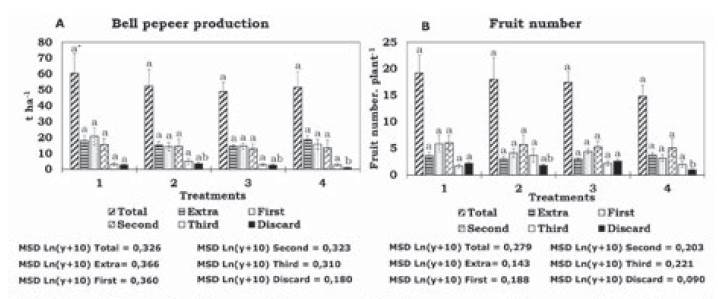
*MSD: minimal significant difference, *Series mean with same letter in each variable, are not statitically different (Tukey, p>0.05) Error bars correspond to the average standard error (SE), n=12
Figure 6 Bell pepper yield -t.ha-1- (A) and number of fruit per plant(B), under the influence of four (4) fertilization treatments. C.I. La Selva, Rionegro-Antioquia, 2014B.
The chemical analysis of plant tissues under Protected crop conditions did not show significant statistical differences among treatments under the same evaluation period (p>0.05). There was no change in the nutrient content of the tissues related to an increase or decrease in the levels of the fertilizers that constituted the four treatments (Table 3).
Table 3 Nutrient content in bell pepper tissues cv. Nathalie under four fertilization treatments in the protected crop condition. La Selva, Rionegro (Antioquia), 2014-B.

* d.a.s. : Days after sowing.
*Values reporte don dry basis. Methods for N determination: EPA 351.3 modified. For P: closed digestion nitric: peroxide: wáter (5:12)/Spectrophotometry. K. a and Mg: closed digestión nitric: peroxide: wáter (5:12)/ Spectrometry of atomic absortion.
**Means with same letter in each column, do not present significant statical differences (Tukey, p>0.05)
**MSD minimal significant difference.
Discussion
The plant height differences among the two evaluated conditions were mainly due to the etiolation caused by the sun-light decreased that was caused by the plastic cover in the protected crop condition. In the open field condition, the RGR-Height stabilized from the 16th week and decreased at the end of the vegetative cycle due to photosynthate translocation, so a stem diameter, fruit production and filling could increase. Under Protected crop condition, RGR-Height did not stabilize and started to decrease from week 18th, affecting the stem diameter, producing thin and flaccid bell pepper plants (Figures 3 and 4).
The climatic characteristics of the two evaluated conditions could explain the adaptive behavior explained above. Hence, temperatures above 8 °C under Protected crop condition generated a 50% increase in d.d. which affected the development of bell pepper cv. Nathalie, despite of having the amount of temperature necessary for its development. The sensitivity to temperature of similar genera is observed in the Open field conditions with the cultivar Pepón (Capsicum chinense), of the report by Jaimez & Rada (2015), in three Venezuelan locations, with different temperatures and altitudes above sea level, where the highest production occurred at the point with the highest average temperature and lower altitude. Additionally, the bell pepper plants reached 50% flowering stage at 46 days after transplantation (d.a.t.) with 756 d.d. accumulated. However, with respect to the present study, d.d. were two (2) times higher than those obtained under Protected crop conditions and six (6) times higher than those in Open field condition. These results exhibited differences in responses adaptation of the cultivar to the environmental conditions marked by a wide range of accumulated d.d.
In order to observe the temperature effect, Erickson & Markhart (2002), evaluated two cultivars, under greenhouse conditions and under a temperature of 33 °C with three intensities (6, 48 and 120 hours, respectively) in different flowering stages. As a result, when flowering in their early stages were exposed for 48 and 120 hours, a reduction in yields was found; this stage corresponded to microspore mother cell meiosis, which, when not completed, resulted in unfertilized flowers.
In other studies, fertilizations above 140 kg.ha-1 of N, under greenhouse conditions with an average maximum temperature of 30 °C, caused a decrease in yields of the hybrid bell pepper "Sandia" due to an exaggerated osmotic effect from salts and fertilizers content (Villa, Ulery, Catalán & Remmenga, 2003). Similarly, fruit reduction by high temperatures has been associated with the reduction in the concentrations of reducing sugars in flower buds, flowering and to an increase on ethylene production (Erickson & Markhart, 2002).
With respect to the obtained yields in the present research, compared with those reported by Albuquerque et al. (2012), where the maximum production of bell pepper (23.2 t.ha-1) was obtained by applying the highest dose of potassium (120 kg.ha-1 K2O); the best treatment with 40 kg.ha-1 less K2O, resulted in a yield of 53 t.ha-1 (72 and 35 t.ha-1 in Open field and Protected crop conditions, respectively. Figure 5). In fact, in a previous work, Casilimas et al. (2012), in the Bio-Systems Center of the Jorge Tadeo Lozano University of Bogota-Colombia, obtained yields with bell pepper cv. Nathalie of 1.9 Kg.plant-1 with 15.2 fruit.plant-1 and 2.5 plants.m-2, under glass covert with controlled conditions, surpassing the obtained yield in 0.6 kg and 3 fruit per plant, with three (3) plants.m-2 under plastic cover in the present study (1.3 kg and 12.1 fruit/plant). However, a lowest yield in 0.9 kg and 7 fruits per plant than those obtained in the Open field condition (2.8 kg and 22.6 ruit. plant-1). With another cultivar such as Lirica, they obtained 3.3 Kg.plant-1 with 22.3 fruit, which shows the importance of having a certification, in face of the competent authorities, of the materials behavior commercialized in Colombia, in different environments for which they are recommended.
In absence of significant statistical differences among treatments, which are presented in the current study (Figure 6), according to Sadeghian (2008), it was confirmed about the limited response of crops with high fertility soils where low fertilization doses are required to obtain good responses in terms of yield and maximum productions. Likewise, a low fertility demands more nutrient doses.
Aminifard et al. (2012) found similar yields for Open field conditions, with a fertilization of 50, 50 and 100 kg.ha-1 of N, P2O5 and K2O respectively, at a density of 30 x 100 cm, and the fruit yield diminished when the nitrogen dose was increased because of the toxicity in the plants.
More recently, the results of Oliveira, Duarte, De Medeiros, Dias, Da Silva, Lima, & Este (2013), confirm that high doses of fertilizers resulted in a detrimental response to crop development. Combining three fertirrigation treatments, under Protected conditions, with the hybrid Atlantis rectangular type, they found the highest number of fruit per plant (29) with doses of 270.9 and 474.8 kg.ha-1 of N and K2O, respectively, and where fruit reductions in treatments with high levels of fertilization were caused by the higher failures rates, associated with an electrical conductivity soil increased and a toxic effect of the accumulated fertilizers, which caused a water and nutrients intake reduction of the hybrid. In addition, the possible energy demand is used by the plant to adjust the osmotic pressure in the absorption of nutrients and water.
For agroecological conditions of research center La Selva, treatment T3 (100, 40, 80 and 40 kg.ha-1 of N, P2O5, K2O and MgO, respectively) is recommended, accompanied by 80 kg.ha-1 of a fertilizer composed of minors elements (8, 5, 18, 6, 1.6, 1.0, 0.75, 0.005 and 2.5% of N, P2O5, CaO, MgO, S, B, Cu, Mo and Zn, respectively), because their yields did not show significant statistical differences from the other three evaluated treatments, maintaining the soil fertility, avoiding its salinization, under a rational use of simple fertilizers.
The nutrients in plant tissues under protected crop conditions, showed no direct relationship with the evaluated levels in all treatments (Table 3), but nitrogen, phosphorus and potassium content in plant stems, decreased towards the end of the vegetative cycle, possibly due to their translocation to use them in fruit production.
The highest nutrient content was presented in leaves, at normal and high levels without presenting deficiencies, according to the reported parameters of Calderon (2017), Weir & Cresswell (1993). The soil organic matter was an important source of nutrients for bell pepper cultivation throughout mineralization processes, for that reason its contents were not deficient in the treatments with smaller applied doses.
The lowest yields obtained under Protected crop conditions were not due to crop nutrient deficiency. Similarly, some contents were presented in a previous work by Marcussi (2005), in leaf tissues of cv. Elisa under Protected crop conditions where the highest concentration throughout the vegetative cycle was potassium (5.1%), followed by nitrogen with 3.8%, calcium 2.4% and phosphorus with 0.44%. Similar average concentrations in fruit tissue were found by Alburquerque et al. (2012), with the hybrid Maximo's F1, combining irrigation sheets and potassium doses as follows: 2.3; 0.35; 2.7; 0.35 and 0.17% of N, P, K, Ca and Mg respectively, with doses of 80 kg.ha-1 of K2O, producing yields of 23.2 t.ha-1; being 68% lower than the obtained production under Open field condition in the present study.
The same as Rodriguez, Bolañoz & Menjivar (2010), with the hybrids of chili pepper (Capsicum spp.) Cayenne Durkeey and Jalapeño Ixtapa, in Palmira (Valle del Cauca, Colombia) in an Open field condition, with the best treatment of complete chemical synthesis, plus humic - fulvic acids applied weekly and inoculated mycorrhizas at sowing time, obtained at the end of the vegetative cycle, N (4.2 - 5.0%), P (0.31 - 0.39%) and K (2.1 - 4.0%) content in leaves, similar to those in the present study and slightly higher in Ca (3.2 - 3.5% ) and Mg (1.5-1.6%).
Accordingly to Albuquerque et al. (2012), in addition to fertilizers recommendation, the amount of extracted or exported nutrients by several crops vary widely due to factors such as: cultivar, soil conditions, climatic variations, water availability, obtained productivity and crop cycle.
Conclusions
The recommended fertilization dose for bell pepper cv. Nathalie, under the conditions of research center La Selva, is 100, 40, 80 and 40 kg.ha-1 of N, P2O5, K2O and MgO, respectively, due to the obtained yields, the restoration and maintenance of soil fertility with a rational use of simple fertilizers.
Under medium and high nutrient levels present in the soil, applying more fertilizer than required does not represent an increase in production but rather in costs and soil degradation.
In the evaluated protected crop condition with plastic cover, the yield of cv. Nathalie decreased up to 47% due to the high temperatures reached.
The use of protected environments with plastic covers should not be generalized, it is better to invest resources in knowledge and management of agroecological systems where crops will be established, ensuring an optimum adaptation and competitive yields.














